Services on Demand
Journal
Article
Indicators
-
 Cited by SciELO
Cited by SciELO -
 Access statistics
Access statistics
Related links
-
 Cited by Google
Cited by Google -
 Similars in
SciELO
Similars in
SciELO -
 Similars in Google
Similars in Google
Share
DYNA
Print version ISSN 0012-7353On-line version ISSN 2346-2183
Dyna rev.fac.nac.minas vol.77 no.161 Medellín Jan./Mar. 2010
INTEGRATING SUSTAINABILITY DOWN TO THE OPERATIONAL LEVELS OF A MINING COMPANY
INTEGRACION DE LA SOSTENIBILIDAD EN LOS NIVELES OPERACIONALES DE LA EMPRESA MINERA
JOSE A. BOTIN
Catedrático de la Universidad Politécnica de Madrid (ETS de Ingenieros de Minas de Madrid) Visiting Professor, Colorado School of Mines (Division of Economics&Business), jabotin@iies.es
Received for review June 16 th, 2009, accepted December 6 th, 2009, final version December 21th, 2009
ABSTRACT: Today, most mining companies declare their commitment to the values of sustainability in their Vision, declarations and policies, but not many achieve an efficient integration of those values down into the operational levels of the organization. Corporate commitment is an essential condition for integrating sustainability, but is not sufficient. Another key condition is a business culture where sustainability is a high professional and business value and sustainability objectives are implemented through commitment rather than compliance. Furthermore, the integration process requires of an organizational structure specific roles and integration mechanisms and adequate management systems. In this paper, I would like to focus on the very complex management task for the integration of sustainability down to the operational levels of mining companies, the organizational structures and the management roles and systems required for integration.
KEYWORDS: Mining, Sustainability, Management.
RESUMEN: Hoy, la mayor parte de las empresas mineras declaran su compromiso con los valores de la sostenibilidad en sus declaraciones de Visión de negocio y políticas de empresa. Sin embargo, no muchas logran una integración eficiente de esos valores en los niveles operacionales de la organización. El compromiso corporativo es condición esencial, pero no suficiente, para la integración de la sostenibilidad. Otra condición esencial es una cultura empresarial en la que la sostenibilidad sea un valor profesional y empresarial, de modo que el objetivo de sostenibilidad sea implementado por compromiso personal más que por cumplir una norma. Además, el proceso requiere de una estructura organizativa dotada de mecanismos, roles integradores y sistemas de gestión adecuados. En esta conferencia, pretendo centrarme en la exposición de la compleja tarea de gestión de la integración de sostenibilidad en los niveles operacionales de la empresa minera, la estructura organizativa y los roles y sistemas necesarios para dicha integración.
PALABRAS CLAVE: Mineria, Sostenibilidad, Gestión.
1. INTRODUCTION
The minerals industry is essential to economic prosperity and a better quality of life but, as important as these benefits are, mining activity causes social and environmental impacts on communities that require a responsible mining practice. Many mining companies have acknowledged this challenge and have stated their commitment to the values of sustainability. However, the public perception of the environmental and social performance of the minerals industry remains poor.
2. THE CHALLENGE OF SUSTAINABLE MANAGEMENT IN THE MINERALS INDUSTRY
In 2002, the United Nations Environment Programme (UNEP) published a document title “Berlin II Guidelines for Mining and Sustainable Development”, where it was stated that: “If sustainable development is defined as the integration of social, economic and environmental considerations , then a mining project that is developed, operated and closed in an environmentally and socially acceptable manner could be seen as contributing to sustainable development”.
In this vision, the concept of sustainable management[1] refers to: “The management approach which efficiently integrates economic, environmental and social issues into operations, aiming to create long-term benefits to stakeholders, including shareholders, and to secure the support, cooperation, and trust of the local community in which the company operates.
In practice, sustainable management refers to the process for implementing in day-to-day operations the sustainability principles expressed in the company’s charter. Essential to this aim is i) adapting the company structure to fully integrate sustainability in the decision making processes and ii) Manage for a business culture where sustainability is a high professional and business value.
Therefore, sustainable management implies a real challenge for the minerals industry. This is exemplified by the “Sustainable Development Frameworks” proposed by multi-participant initiatives offering guidance to the minerals industry (ICMM, Global Compact and other). As an example, the International Council of Mining and Metals [2], proposes the “10 Principles of Sustainable Development”, all of them focusing on the issues of strategy implementation, structural integration, continual improvement and other challenging management tasks.
The author’s vision of sustainable management is represented in the graphical model of Figure 1, In this model, sustainability must be vertically integrated at three organizational levels (corporate, divisional and operations) and three functional levels (strategy, planning and implementation) and three social levels (Company, community and other stakeholders). Besides, the implementation of sustainability goals at the different stages of the resource life cycle requires an organizational structure with adequate integration mechanisms and a business culture where sustainability is a high professional and business value.
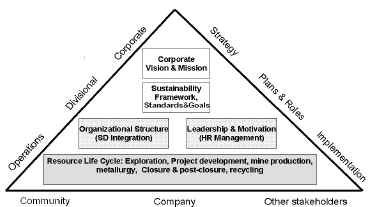
Figure 1. Sustainable Management of Mineral Resource Companies: An integrated model
From the shareholder’s perspective, there is ample evidence of the link between environmental and social performance and company financial performance[3], this is a “Business case for sustainability”. Ultimately, any efficient integration of sustainability must be driven by business considerations, this is, sustainable management practice must lead to improved profitability and added value to shareholders and hence, the potential benefits and costs of sustainability need to be quantified.
The quantitative evaluation of the potential benefits of sustainable management is a complex subject that goes well beyond the scope of this paper but at the conceptual level, these benefits are summarized below:
- Corporate reputation and lower risk profile
- Higher operational efficiency from the implementation of SD management systems (e.g., ISO 14001, ISO 9001), and the continuous improvement philosophy associated with sustainable management.
- Competitive advantage from the access to new mineral resources at lower acquisition cost and reduced project failure rates.
- Advantage in recruiting and retaining human resources resulting in improved leadership and motivation, initiative and decision making at lower levels.
- Easier and more economical project financing derived from the perception by investors of the positive financial consequences of Social License in financing new mining projects.
- Lower project development costs through improved stakeholder’s relation and faster permitting process.
Achieving these benefits has associated costs related to an increased company structure, partnership in community development projects and, in general, the costs of earning and maintaining the social license.
3. CORPORATE STRATEGY AND SUSTAINABILITY
Some of the key strategy issues for sustainability in the mineral industry described by Rebollo[4] are highlighted below.
Contrary to most other businesses, once the ore body has been discovered, the geographical location and other business parameters such as political environment, availability of energy and water, transportation conditions, climate, etc. are locked and little can be done to change them.
Mining and metallurgical activities are still regarded as socially threatening and hazardous. Therefore, sustainable management of these activities requires a “social license to operate”. Because of this fact, a strategic plan for developing such an activity may not be limited to the operational, market and financial considerations but must address social, political and environmental implications that could be crucial for feasibility.
Reputation is an important intangible asset in mining companies. It can be improved in the frame of an intelligent strategy or degraded by wrong policies and poor communication. A good reputation allows the companies to be accepted by its social environment and, as a consequence, increase its capacity to compete in other strategic aspects.
Another important strategic particularity of the minerals industry is the relatively small number of actors and the international – sometimes global – projection of many of them. This fact makes sustainability and corporate social responsibility aspects often become extremely important for the strategy of the company.
At the operational levels, probably the key strategic issue for sustainable management is the relation with the “stakeholders”. In this context, a “stakeholder”[5] is a party which affects, or can be affected negatively or positively by the activities of the company. Although the concept is applicable to any business activity, it is in the minerals industry where it becomes of greatest strategic interest, due to the great diversity and magnitude of its potential (positive and negative) impacts and the controversial legacy of mining around the world throughout history.
Interaction with each stakeholder requires a specific strategy but any efficient interaction with the shareholders of a mining project requires clear objectives, mutual trust and transparency. The Social License is a covenant drawn up between the company and the affected communities and stakeholders. Furthermore, it is dynamic in its nature and must be preserved over time through adapting it to the changes and new circumstances affecting the company and the community.
Table 1 shows a list of some typical mine project stakeholders[6]. Identifying and interacting with the relevant stakeholders is essential to sustainable management. No hard rules exist to identify them but it is of interest the recommendation of the World Bank[7] suggesting that a good way to start the identification process is by asking questions such as:
- Who are the “voiceless” for whom special efforts may have to be made?
- Who are the representatives of those likely to be affected?
- Who is likely to mobilize for or against what is intended?
- Who can make what is intended more effective through their participation or less effective by their non-participation or outright opposition?
- Who can contribute financial and technical resources?
- Whose behavior has to change for the effort to succeed?
Table 1. Typical stakeholders in mining projects
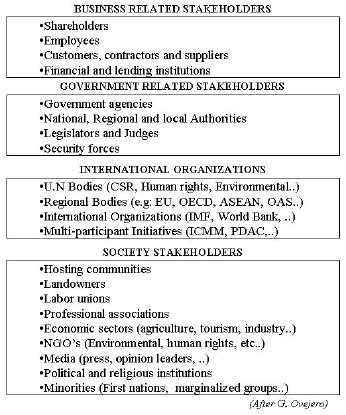
4. CORPORATE SOCIAL RESPONSIBILITY
The World Business Council for Sustainable Development states: “Corporate social responsibility is the continuing commitment by business to behave ethically and contribute to economic development while improving the quality of life of the workforce and their families as well as the local community and society at large” [8] . As a business value, CSR can help safeguard license to operate; facilitate access to capital; contribute to reputation, and enhance stakeholder engagement, including employees and overall, it contributes to sustainable management and the reduction of business risk.
It is also understood that CSR implies the voluntary acceptance by the companies of social responsibilities, sustainability standards and codes of ethics above and beyond legal requirements. To this end, mining companies may align their codes of conduct and sustainable development frameworks, such as :
- The International Council of Mining and Metals (ICMM)
- The United Nations Global Compact (www.unglobalcompact.org)
- The Prospectors and Developers Association of Canada - PDAC (http://www.pdac.ca/)
- Global Reporting Initiative- GRI (http://www.globalreporting.org/)
In most cases, these corporate values include considerations towards ethics, social license, and safety and clearly represent a commitment to upholding standards and codes of conduct relative to company employees, local communities, the environment, and stockholders/investors.
5. HUMAN RESOURCES MANAGEMENT AND THE SOCIAL LICENSE
Probably, one of the most prominent risks now facing mining and resource companies involves their ability to develop and maintain a social license to operate[9]. While the legal authority to mine a specific property is embodied in the regulatory consent granted by governmental agencies, this “right to mine” is only as valid as the explicit or implicit social license granted by the potentially affected communities and stakeholders. In exchange for this social license, mining companies make a commitment to local communities to provide tangible benefits and improve the quality of life of residents during and after mining.
The Social License is a covenant drawn up between the company and the affected communities and stakeholders. Furthermore, it is dynamic in its nature and must be preserved over time through adapting it to the changes and new circumstances affecting the company and the community.
Employees play a critical role, often overlooked, in facilitating this social license. Freeman, 2009[9] stated that employees serve as an important conduit for disseminating information about the company and its practices to the general public and hence, everything associated with human resources management, directly or indirectly impacts a company’s reputation and how they are perceived by local communities. In addition, employees are key in conveying important information back to the company about social and community issues, a feedback which is critical for assessing the outcomes of specific social programs and identifying key factors that might indicate community needs or potential conflicts.
Company culture and ethics are perhaps the two most critical HR management issues for sustainability. Company’s ethics are inherently defined by the behaviour of its employees. Ethics is a complex subject beyond the scope of this paper. Suffice to say that although companies often have well-defined codes of ethics, standards and policies that precisely define the limits of ethical conduct of employees, a company’s ethics are usually defined by the behavior of its employees with respect to “grey areas”, that is, when in the absence of prescriptive policy or standards, employees behavior is based upon their own interpretation of the situation. For example breeches of ethics such as theft and lying are easy to define but, Is it ethical to exaggerate for personal gain?. How about corporate intelligence?. A Company’s ethics are often characterized through these grey areas.
Regarding company culture, sustainable management requires a culture where sustainability is a motivating corporate and professional value so that sustainability objectives may rely on personal commitment rather than compliance with policy and regulations, thus allowing for maximum degree of decentralization of decision making in sustainability issues.
6. INTEGRATING SUSTAINABILITY INTO COMPANY STRUCTURE
As an important area of corporate strategy, sustainability must be integrated within the corporate decision-making process at all management levels. This integration process, often difficult and challenging, requires an organizational structure with integration mechanisms, management roles, plans and systems ensuring proper communication, coordination and control. Integration roles are individual positions or ad-hoc committees with accountability for the integration of sustainable development values and objectives. Integration plans and systems are the policies, standards and the management tools which are required to carry out sustainable management at operations level.
As an example (Figure 2), exemplifies the sustainable management structure for a large minerals corporation and highlights the integration mechanisms for sustainable management. The model would also be conceptually valid for medium size or small companies, where the divisional level would not exist.
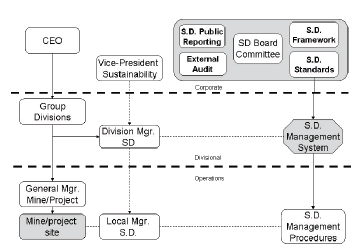
Figure 2. The process of integration of sustainability in the company structure
At corporate level, three roles are key to sustainable management:
- The CEO role, developing a business vision, formulating challenging goals and reinforcing motivation toward the values of ethics and sustainability.
- The SD Committee, assisting the Board in overseeing SD framework and standards, evaluating performance, public reporting and external auditing.
- The VP Sustainability, a key leadership role, normally a staff to the CEO, who is accountable for setting strategy, establishing goals and integrating sustainability down and across the organization. Among other tasks, the VP Sustainability should assist divisional heads on sustainability matters, cooperation with HR in developing sustainability values in employees.
At the divisional level, the Divisional Managers, Sustainability are accountable to the VP, Sustainability and coordinate sustainability issues with the Division heads. Here, the key roles are related to the efficient integration of sustainability standards, the implementation of management systems for evaluation and control of SD goals and the management of the sustainable development reporting.
At operational levels, the site Manager, Sustainability report to the operations general managers with overall accountability for the implementation of sustainability procedures at operational level.
Sustainable Development Standards are a set of management standards issued to interpret and support the Sustainable Development framework and policy on sustainability at all management levels in the company. Also, the SD Standards act to formalise the conceptual base for the design and implementation of management systems. In many cases, SD Frameworks and Standards are designed in full alignment with international SD frameworks (ICMM, Global Compact, etc.). As an example, XSTRATA PLC has a SD developed System based on the Standards listed in Table 2.
Table 2. Typical Sustainability Management Standards of Mining Company
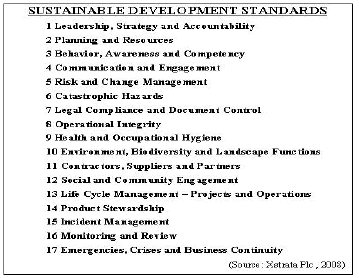
The SD Management Systems are tools supporting the implementation of SD objectives (planning and control) and to manage for a hierarchical performance reporting system to allow for analysis and decision taking at all levels.
Sustainability Reports are often designed in alignment with global reporting standards. Probably the most widely used minerals industry reporting standard is the Global Reporting Initiative (GRI). GRI has published a public reporting guide specifically designed for the Minerals Industry, which was developed in cooperation with the International Council on Mining and Metals (ICMM).
Only publicly listed Companies are required to issue an independently assured annual report on sustainability. However, many non listed mining companies issue independently assured reports seeking the very positive effect on reputation and credibility with respect to sustainability and Corporate Social Responsibility.
Audits are normally performed on an annual basis by the internal audit team under the direction of an independent auditor. The objective is to provide independent assurance that the management practice and performance are in compliance with the SD standards and public reporting of the Company.
Assurance practices of mining companies vary widely but there is increasing use of standards such as AA1000.
7. MANAGING PROJECT DEVELOPMENT AND OPERATIONS
Implementing sustainable management in day to day operations is difficult to accomplish and describing the systems and procedures required is very complex and well beyond the scope of this paper. However, we will highlight that any approach to sustainable operations management relies on the identification of expectations expressed by local stakeholders and its integration with those identified in corporate sustainability standards.
In this regard, Van Zyl et al [10] describes a powerful methodology - “Seven Themes of Sustainability” – which may be used to develop broad management guidelines. The methodology consists in analyzing management decisions from the perspective of the “Seven Themes”, as described in Table 3, to identify some sustainable management considerations.
Table 3. Management Considerations and the Seven Themes to Sustainability
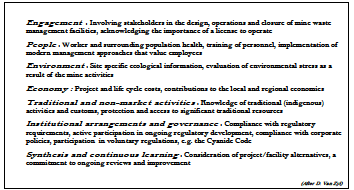
8. CONCLUSIONS
- In the context of the minerals industry, sustainable management refers to a management approach that integrates sustainability across the organization: i) At all organizational levels (corporate, divisional and operations), ii) At all functional levels (strategy, planning and implementation) and iii) In all stages of the resource life cycle (Exploration, project development, mining and metallurgical operations, closure & post-closure).
- Sustainable Management deals with seeking for long term competitive advantages through responsible management of economic, environmental and social issues. Achieving these advantages has associated costs related to the development of a sustainability driven business culture, the partnership in community development projects and, in general, the costs of earning and maintaining the social license.
- The social license to operate relies on individual ethical conduct and trust to foster participation of stakeholders and encourage commitment among them. Therefore, sustainable management requires a business culture where sustainability is a self-motivation professional value and decisions are driven by commitment rather than compliance with policies and regulations.
REFERENCES
[1] BOTIN, J.A. ed. Sustainable Management of Mining Operations. Society for Mining, Metallurgy and Exploration (SME). Littleton, Co., USA . 2009. [ Links ]
[2] INTERNATIONAL COUNCIL OF MINING AND METALS. Sustainable Development Framework. May 2003. [ Links ]
[3] GRIEG-GRAN, M. Financial Incentives for Improved Sustainability Performance: The Business Case and the Sustainability Dividend. MMSD project of IIED and WBCSD. 2001. [ Links ]
[4] REBOLLO, J.L. Strategy issues in the Mineral Industry. Sustainable Management of Mining Operations, Botin Ed. Chapter 4. Society for Mining, Metallurgy and Exploration (SME). Littleton, Co., USA . 2009. [ Links ]
[5] EDWARD FREEMAN, R. Strategic Management: A Stakeholder Approach. ISBN: 0273019139. 1986. [ Links ]
[6] OVEJERO, G. Project Management and Stakeholders. Sustainable Management of Mining Operations, Botin Ed. Chapter 8. Society for Mining, Metallurgy and Exploration (SME). Littleton, Co., USA . 2009. [ Links ]
[7] WORLD BANK. IBRD. Participation sourcebook. ISBN 0-8213-3558-8. Washington D.C. 1996. [ Links ]
[8] WBCSD ( Mike Wright), Corporate Social Responsibility: What stakeholders in emerging economies had to say, presentation at the Corporate Citizenship Conference, The Royal Institute of International Affairs, Chatham House, London, November 8, 1999. [ Links ]
[9] FREEMAN, L. and MILLER, H. Human Resources Management. SME Annual Meeting. Technical Session on Managing for Sustainability in the Minerals Industry. Denver, Co. USA . Society for Mining, Metallurgy and Exploration (SME). Littleton, Co., USA . 2009. [ Links ]
[10] VAN ZYL, D., LOHRY, J. and REID, R. Evaluation of Resource Management Plans in Nevada Using Seven Questions to Sustainability, In: Proceedings of the 3rd International Conference on Sustainable Development Indicators in the Mineral Industries, Z. Agioutantis (ed), Milos Conference Center, pp 403-410. 2007. [ Links ]














